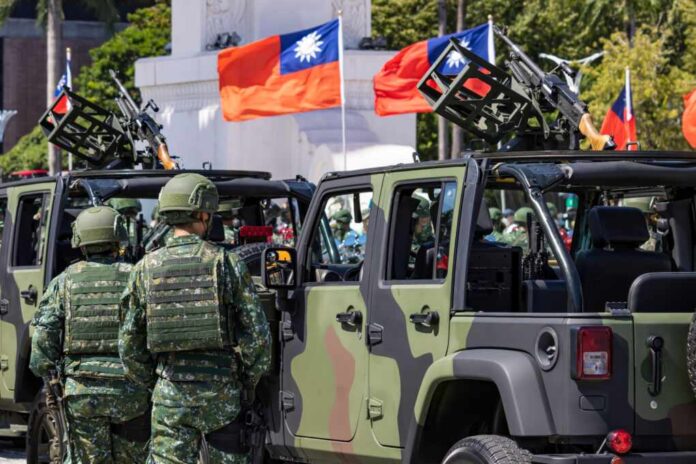
Taiwan has accelerated testing of supersonic “carrier killer” missiles on indigenous fighters, marking a critical step in building credible deterrence against China’s growing naval threat.
Story Highlights
- Taiwan fast-tracks air-launched Hsiung Feng III missile integration with F-CK-1 fighters
- Supersonic anti-ship missiles designed specifically to counter Chinese aircraft carriers
- Indigenous defense technology reduces reliance on foreign weapons systems
- Live-fire trials planned following successful captive carry and drop tests
Indigenous Defense Capabilities Accelerate
Taiwan’s National Chung-Shan Institute of Science and Technology (NCSIST) has expedited testing of the air-launched Hsiung Feng III supersonic anti-ship missile on Republic of China Air Force F-CK-1 Ching-kuo fighters. The accelerated timeline includes captive carry trials and drop tests conducted throughout August 2025, with data collection aimed at informing upcoming live-fire exercises. This represents the first public evidence of HF-III integration with Taiwan’s indigenous fighter aircraft, demonstrating the island’s commitment to self-reliant defense capabilities.
BREAKING; TAIWAN Air Force tests Hsiung Feng III missile to send a signal to CHINA!! pic.twitter.com/PDWRRRFClp
— Recon & surveillance (@Recon_surv) August 6, 2025
Carrier Killer Technology Enhanced
Defense analysts describe the Hsiung Feng III as a “carrier killer” missile specifically engineered to threaten large surface vessels, particularly Chinese aircraft carriers operating in the Taiwan Strait. The supersonic missile’s air-launch capability significantly extends operational range and enhances survivability compared to surface-launched variants. Taiwan recently expanded its HF-III arsenal with procurement of 232 additional missiles, underlining the strategic importance of this weapons system in countering China’s naval expansion.
Strategic Response to Regional Threats
The missile integration program directly addresses escalating Chinese military pressure in the Taiwan Strait region. Air-launched capabilities provide Taiwan’s air force greater operational flexibility and survivability against numerically superior adversaries. The F-CK-1 Ching-kuo, developed in the 1980s to reduce foreign dependency, now serves as the platform for Taiwan’s most advanced anti-ship missile system. This asymmetric warfare approach leverages advanced technology to offset China’s overwhelming naval advantages.
Taiwan’s defense strategy emphasizes indigenous weapons development to maintain credible deterrence while reducing vulnerability to foreign arms embargoes. The successful integration of the HF-III with the F-CK-1 validates Taiwan’s domestic defense industry capabilities and signals resolve to defend against potential amphibious assaults. Regional security experts note that credible deterrence remains essential for maintaining stability in one of the world’s most strategically important waterways.
Testing Progress and Future Operations
Current testing phases include simulated launches and data collection operations designed to validate missile-aircraft integration before live-fire trials commence. NCSIST officials emphasize the need for rapid capability enhancement given heightened regional security threats and increasing Chinese military activity. The successful completion of captive carry and drop trials marks significant progress toward operational deployment of this enhanced maritime strike capability.
Sources:
Hsiung Feng III Anti-Ship Missiles Seen on Taiwan’s F-CK-1 Ching-kuo
F-CK-1 fighter jets of the Taiwanese Air Force carried out simulated launches of the new version of the HF-3 anti-ship missile
Hsiung Feng III Anti-Ship Missiles Seen on Taiwan’s F-CK-1 Ching-kuo
Taiwan Expands Arsenal With 232 Hsiung Feng III Supersonic Missiles to Deter China

























